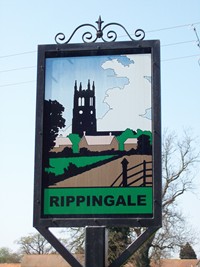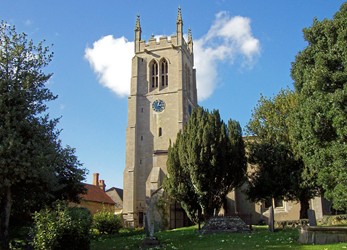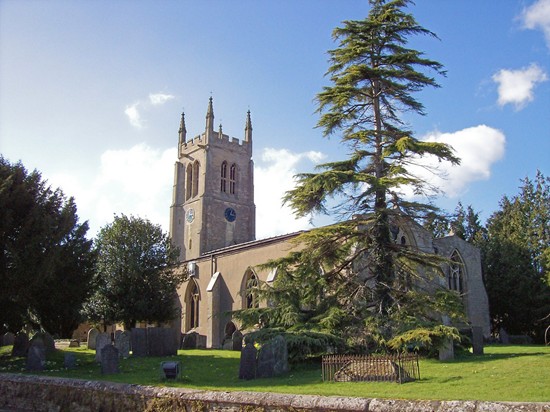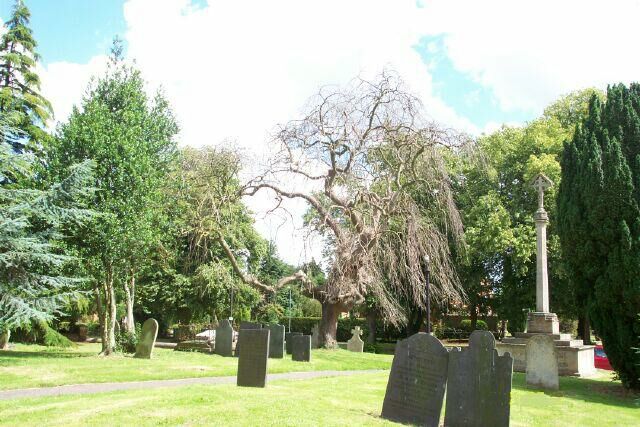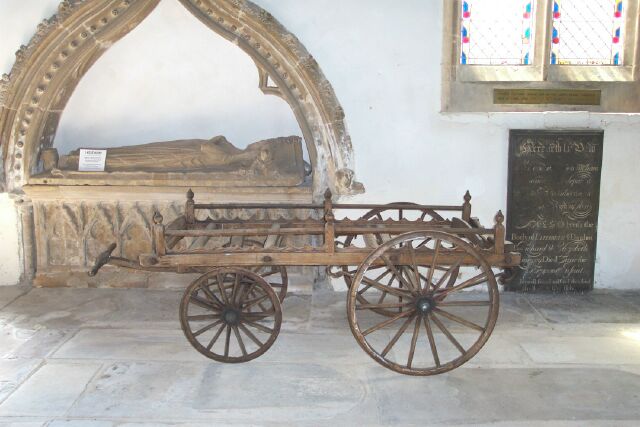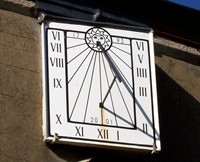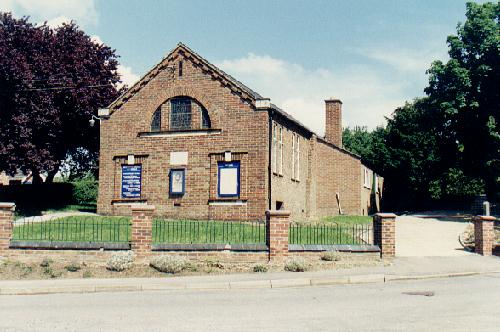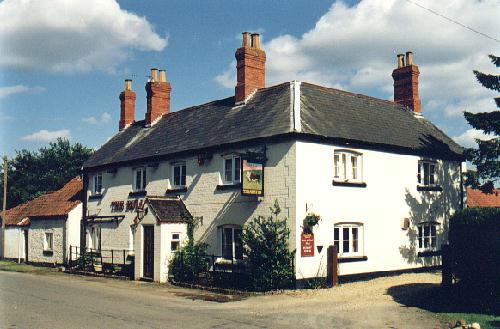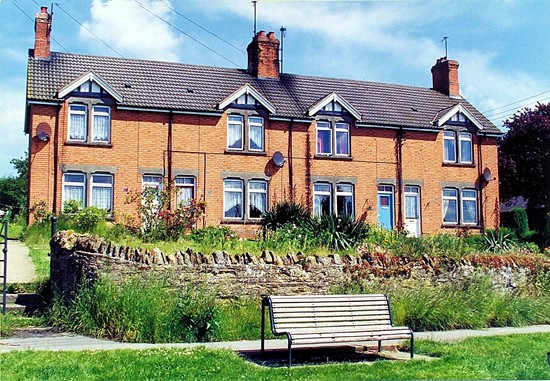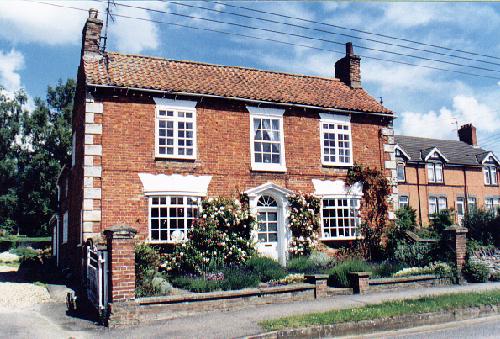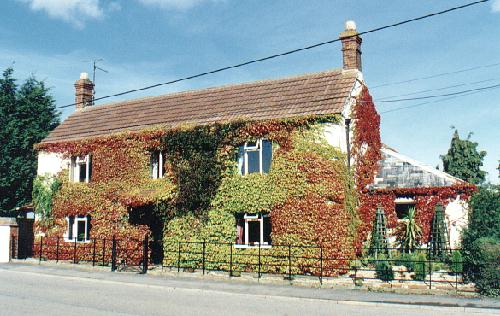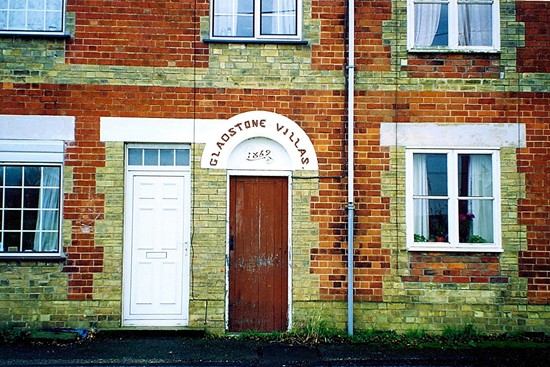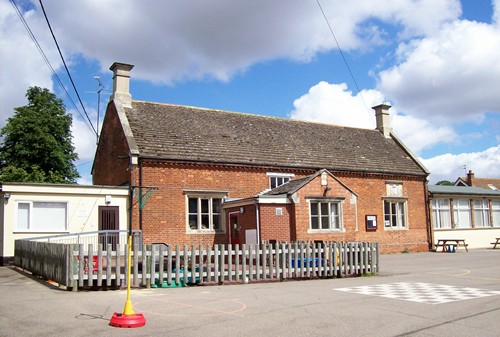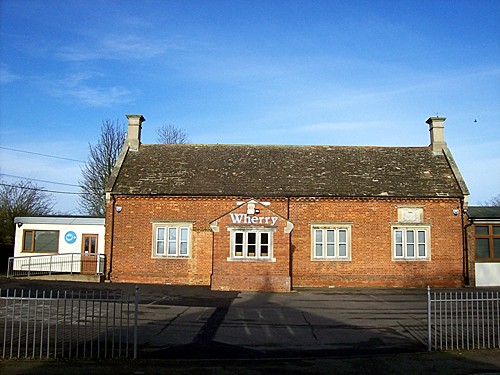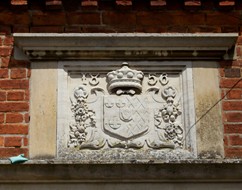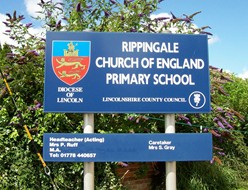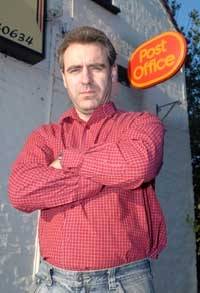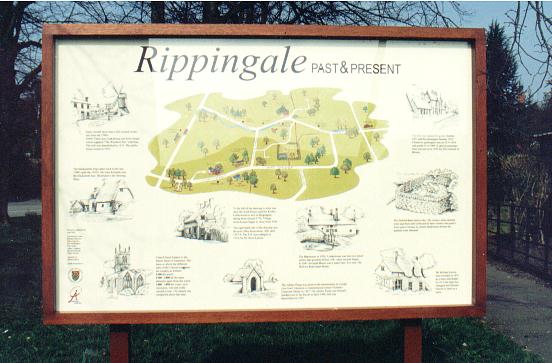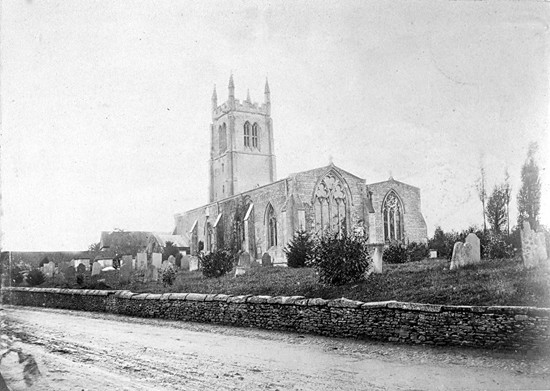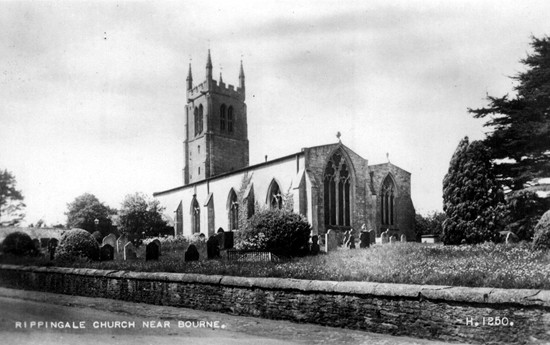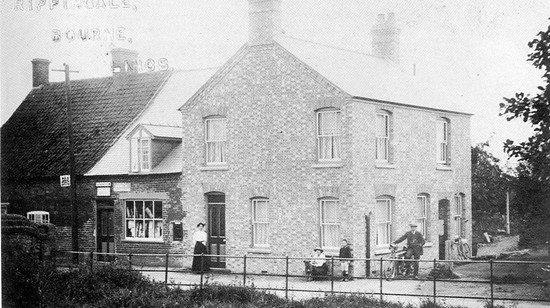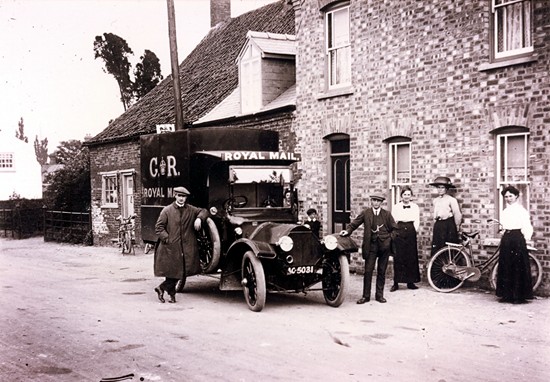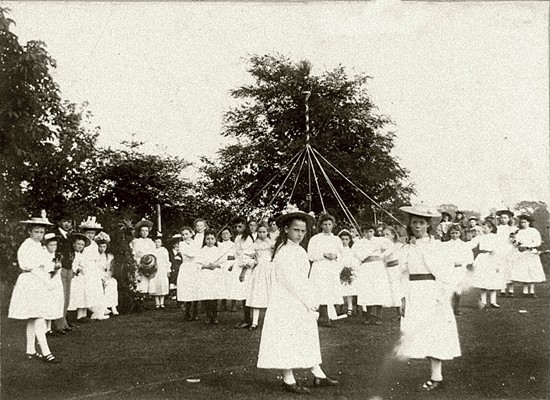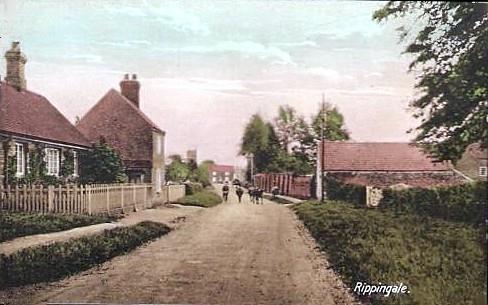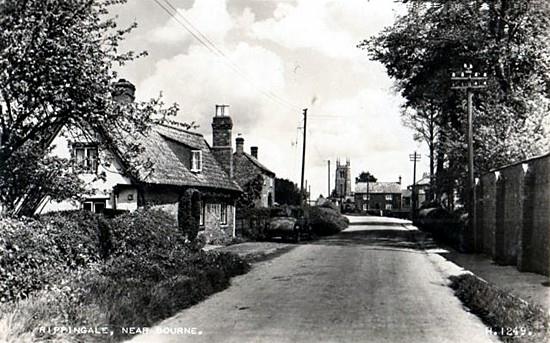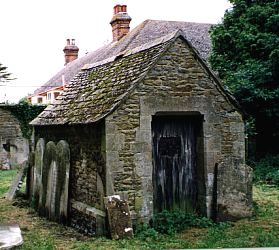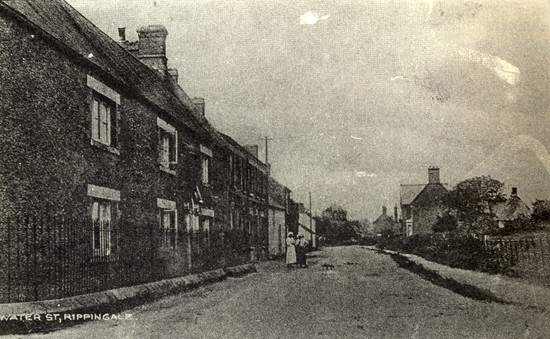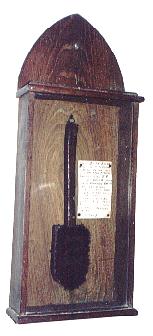|
Rippingale
The grand battlemented tower of St Andrew's Church which is depicted in the village signs at Rippingale, five miles north of Bourne, stands on the edge of the fen, a distinctive landmark from the 15th century with its tall pinnacles and built in the Perpendicular style. Inside, the church is chiefly Decorated in style with a spacious nave of six bays and large traceried windows and contains an exceptional display of mediaeval monuments and effigies which speak of the importance of this village in the Middle Ages. There is also a church chest of some age and dated 1785, the numbers picked out in bright studs on the front. The chests of the 18th century were plainer than the elegant examples of the earlier century which are now known as Jacobean, although smoothly finished designs such as this were extremely popular, almost always dated and sometimes also bearing the initials of the churchwardens. The limestone war memorial in the churchyard which was built after the Great War of 1914-18 as a tribute to the fallen from the village had deteriorated so much by 2006 that a refurbishment scheme was initiated with £5,000 from English Heritage and the parish council. Previously hidden lettering was restored and frost damage repaired.
Although the tower of St Andrew's Church is 15th century, much of the building is older with a 13th century porch leading to a 14th century aisle separated from the nave and chancel by an arcade of six pointed arches on clustered pillars. A simple brass inscription in the aisle tells of a remarkable lady, Elizabeth Hind, who died in 1921 in her 102nd year and the church registers record the death in 1815 of Anne Hardy, a girl of 16 who was a giantess 7 ft 2 in tall. One of the features of the church interior is the font of golden mellowed stone and dating back to the early 15th century.
The parish bier on which coffins were carried to the church for the funeral and then to the graveside for burial is on display in the church. It is made of wood and is thought to date from 1900 but has been superseded in modern times by the motorised hearse. A sundial can be seen on the wall alongside the south porch although this is a copy of the original which was originally installed in the late 18th century. The church records state: “One sundial located on the south wall to the east of the main porch. The dial is rectangular with black painted numerals on a light background and a metal angled arm protruding from the centre. The date on the dial is 1793. The face is angled towards the south west.” The sundial weathered badly over the years and was removed on the recommendation of the church architect during one of his quinquennial inspections but it was replaced in September 2001 by the parochial church council and the original preserved in a glass case, temporarily kept in the vestry pending the required permission from the diocese to place it in a permanent position against one of the walls, probably in the nave, where it can easily be inspected by visitors.
Methodism began in Rippingale about 1817 due to influences from Aslackby and the first services were held in an old barn but despite opposition from local tenant farmers, a chapel was built in 1832 with a stable adjoining for the preacher's horse, most of them visiting from elsewhere. The site was owned by Sir Gilbert Heathcote who was paid a land rent of 10s. a year. There were 13 members in 1820 but this number had risen by 1851 when 88 adults attended afternoon service with 79 children meeting in the morning and 75 in the afternoon. Attendance however declined towards the end of the century and by 1890 it had dropped to 23 but had risen considerably by July 1932 when the chapel's centenary was celebrated with a special service followed by a tea in the barn owned by local farmer Mr William Sands attended by more than 100 people.
But the chapel needed extensive repairs and so members decided to build a new one which was erected in 1935 at a cost of £1,050. Several stones were laid to mark the occasion by local residents and 29 bricks by Sunday School scholars. The new chapel was registered for worship on 18th November 1935 and for the solemnisation of marriages on 10th June 1957. In August 1982, a large number of members marked the 150th anniversary of the building of the first chapel with a weekend of special events culminating with celebratory services on the Sunday.
The new chapel however did not survive long into the 21st century. Falling attendance figures and subsidence in the building brought about its closure in 2004. Huge cracks had appeared in the walls and repairs were costed at £75,000, an impossible amount to raise at a time when the congregation on some Sundays was down to only eight worshippers. The final service of thanksgiving was held on Sunday 11th January 2004 to mark the end of its 68-year life and ironically, the chapel was full including some people who had been there when the first service had been held in 1935. The building was eventually demolished and the site used for new houses, built in 2007, while Methodists from Rippingale now attend the chapel at Bourne.
The village pub at Rippingale is the Bull, built as a coaching inn at the turn of the 19th century while the name is a reminder of an old and popular so-called sport now long gone, that of bull baiting which almost certainly took place in the vicinity. The bull was tethered to an iron ring and then the dogs were loosed upon the poor beast but the law forbade this practice in 1835.
It has been claimed that Ambridge, the village featured in the long running BBC Radio serial The Archers, was based on Rippingale and that The Bull is the public house because Henry Burt, the agricultural adviser who came up with the idea for the programme, lived at nearby Dowsby Hall. But this is unlikely and the village of Inkberrow in Worcestershire with its own Old Bull Inn is the more favoured candidate. Not only did Godfrey Baseley, creator of the daily soap opera live nearby but the BBC has also used the village in its publicity shots for the Radio Four programme. Nevertheless, rival claims break out in the newspapers periodically and although villagers at Rippingale agree that Inkeberrow is the modern day Ambridge, its birthplace was Rippingale where the idea, original scripts and characters were conceived and born.
Rippingale railway station was built in 1871 and opened for goods traffic on the line between Bourne and Sleaford in October of that year while passenger trains started running the following January. The services closed completely almost a century later and the Victorian building through which generations of travellers had passed has since been turned into a private house but many of the artefacts of the steam age can still be seen in the vicinity.
The solid red brick building which stands in Fen Road almost a mile outside the village is being sympathetically restored and extended but has retained its original appearance and the platform is intact although the rails and sleepers have been removed but the old British Railways sign still hangs on the wall. The village lost its passenger service on 22nd September 1930 which was quite an event at the time because ninety-nine stations and seventeen lines closed nation-wide on that day. The line and the station however remained open for goods and special passenger trains, the last of which was in 1951 when local people were picked up here for a visit to the Festival of Britain in London. Potatoes, grain and sugar beet were carried along the track in the ensuing years until the final closure came on 15th June 1964.
The old goods shed and other outbuildings remain on site and are also being renovated by the owner, railway enthusiast John Scholes, while rails and sleepers are piled up nearby. One short stretch of track can also be seen with a steam locomotive standing on the rails, once rusting and deteriorating but it may not be the end of the line because it is now being restored. This engine is in fact an Avonside locomotive, Works No 1972, built in 1927, and called Stamford and will soon be moved into the goods shed for further refurbishment work. It was once in service with the Ketton Cement Company which is based near the town but was purchased by Mr Scholes when its working days were over. The Stamford is sister to a consecutive locomotive called Dora which is currently in service at the Rutland Railway Museum.
The village school was built in 1856 by Lord Aveland (formerly Sir Gilbert Heathcote), lord of the manor of who owned large estates in the area.. Prior to that, classes were held at the village church in St Anne's Chapel which was boarded off from the rest of the building. Financial support was provided by the Brownlow family and as a result of this, an annual payment of £5 is still made to the governors by the owner of Manor Farm. The school was opened on Tuesday 28th October 1856 with due celebration, as reported by the Stamford Mercury:
This village was enlivened on Tuesday last by some slight manifestation of rejoicing and gaiety in commemoration of the opening of the new school erected by Lord Aveland. Early in the morning and during the day, the church bells pealed merrily and flags and garlands were displayed around the festive spot. 110 children were regaled with roast beef and plum pudding at one o'clock, under the presidency of the Rector [the Rev William Cooper], assisted by his churchwarden, Mr Richard Quincey. The overseers, Messrs Edward Healey and Henry Chapman, acted as vice-presidents. After dinner, amusements of a most jovial nature were indulged in by the children and visitors and in the evening, fireworks were discharged. The schoolroom was tastefully decorated by the ladies of the village and great praise is due to the Rev W Cooper and his lady for the zeal and exertion manifested by them to procure such a "day of remembrances". The day's proceedings concluded with "God save the Queen". The dinner was provided by voluntary subscriptions from the parishioners.
The school was built to accommodate 130 pupils of all ages and the premises were enlarged in 1899 when a new classroom was added together with cloakrooms and offices, the work paid for by the Earl of Ancaster. In 1876, it was listed as a public elementary school and the master was John Caunce with Miss Jane Hind as mistress but by 1885, his wife, Mrs S F Caunce, had become mistress and the average attendance was 95, a figure that had dropped to 87 by 1900 and to 70 in 1913 when Horace Edmund Sharpe was master. Further extensions to the premises were carried out in 1956 after it had become a junior school in 1949 and it subsequently became known as Rippingale Church of England Primary School. Fifty years later, attendances had begun to decline dramatically and by Easter 2007 pupil numbers had fallen to a mere 20, despite efforts by the governors to attract more from the locality. As a result, Lincolnshire County Council, the education authority, decided that it was no longer financially viable and the school was closed at the end of the summer term in July.
County councillor Patricia Bradwell, executive councillor for children's services, said that although there were 132 children living in close proximity, parental preference was for other schools in the area and this had brought about the closure. "It is always a great disappointment to see schools such as this shut when they should be at the heart of their communities", she said. The closure was marked on the last day of term, Friday 20th July, with a special service for pupils and staff both past and present conducted by the Bishop of Grantham, the Venerable Dr Tim Ellis. The remaining pupils and staff were transferred to the village school at Horbling although some teachers and assistants were made redundant.
An attempt by Rippingale Parish Council to preserve the building failed after an application was turned down by English Heritage who decided that although there was merit in the blue slate roof, the exterior design had suffered damaging alterations and therefore did not merit a Grade II listing. In September 2008, the Diocese of Lincoln, which owns the school building, and Lincolnshire County Council, which owns the adjoining playing field, instructed agents to assess the future of the site and in the summer of 2011, it was sold to the old-established Bourne seed company Wherry and Sons Ltd who planned to convert it for use as their offices..
REVISED JULY 2015 See also German prisoners of war Ran-tanning Henry Bromley The doctor's surgery The post office
Go to: Main Index Villages Index |
|||||||||||||||||||||||||||||||||||||||||||||||||||||||||||||||||||||||||
